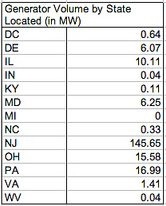The recognition of out-of-state SRECs in Maryland has been a fairly ambiguous topic for quite some time now. According to the RPS solar carve-out law in Maryland, statute §7–701:
(i)“Renewable energy credit” or “credit” means a credit equal to the generation attributes of 1 megawatt–hour of electricity that is derived from a Tier 1 renewable source or a Tier 2 renewable source that is located:
(1) in the PJM region; or
(2) outside the area described in item (1) of this subsection but in a control area that is adjacent to the PJM region, if the electricity is delivered into the PJM region.
This means that Maryland buyers can procure SRECs from anywhere in the PJM region or a “control area” bordering the region if the electricity is delivered into the region.
Later, the law gets even trickier in §7–704 to say:
“On or before December 31, 2011, energy from a Tier 1 renewable source under § 7–701(l)(1) of this subtitle that is not connected with the electric distribution grid serving Maryland is eligible for inclusion in meeting the renewable energy portfolio standard only if offers for solar credits from Maryland grid sources are not made to the electricity supplier that would satisfy requirements under the standard and only to the extent that such offers are not made.”
Note that § 7–701(l)(1) refers to solar specifically. This makes things even more confusing because what it attempts to say is that Maryland buyers can purchase SRECs from facilities not connected to the grid serving Maryland until the end of 2011 as long as they can prove they cannot source SRECs from within the grid serving Maryland.
What does that even mean? Is the “electric distribution grid serving Maryland” the same as the PJM Region? Is it just the state of Maryland? Is it the PJM Region plus adjacent control areas as long as the electricity is delivered into the PJM Region? Furthermore, how does a buyer prove that they can’t fulfill their requirements within the electric distribution grid, so that they can get approval to buy from facilities not connected to the grid?
Our interpretation: If you’re not connected to the electricity grid serving Maryland, it’s probably not worth the trouble to apply. For starters, if you can sell them, your SRECs are only usable in 2011. In addition, the buyer would need to provide proof that they can’t procure SRECs from within the grid serving Maryland. Assuming that this refers to the PJM Region, then it is highly unlikely that buyers in Maryland would not be able to procure SRECs from within the grid. And finally, onerous requirements like “Mail the original and 14 paper copies of all documents” in the Maryland application process make it one of the most tedious state certifications out there.
What we do know is that there are 2.3 MW of projects outside Maryland that are currently registered in the state and generating SRECs in GATS. These facilities are from: DC, DE, IL, NC, NY, OH, PA, VA, WV. Of the 107 facilities from outside Maryland, 63 were built in 2010. All of these states are within the PJM Region with the exception of NY, which had 4 facilities from 2004-06 approved. It is likely that the Maryland Public Service Commission has since stopped accepting NY facilities and other facilities from outside the PJM Region.
While we can’t predict how buyers view out-of-state SRECs in Maryland, we now have an in-state/out-of-state option for buyers in the Maryland SREC auction. If you have a facility that is located in the PJM region, we would encourage you to apply to the Maryland SREC market (despite the impact that 14 copy requirement might have on the environment). Instructions can be found on our State Certifications page. We can also do it for a fee if you are an EasyREC customer.




